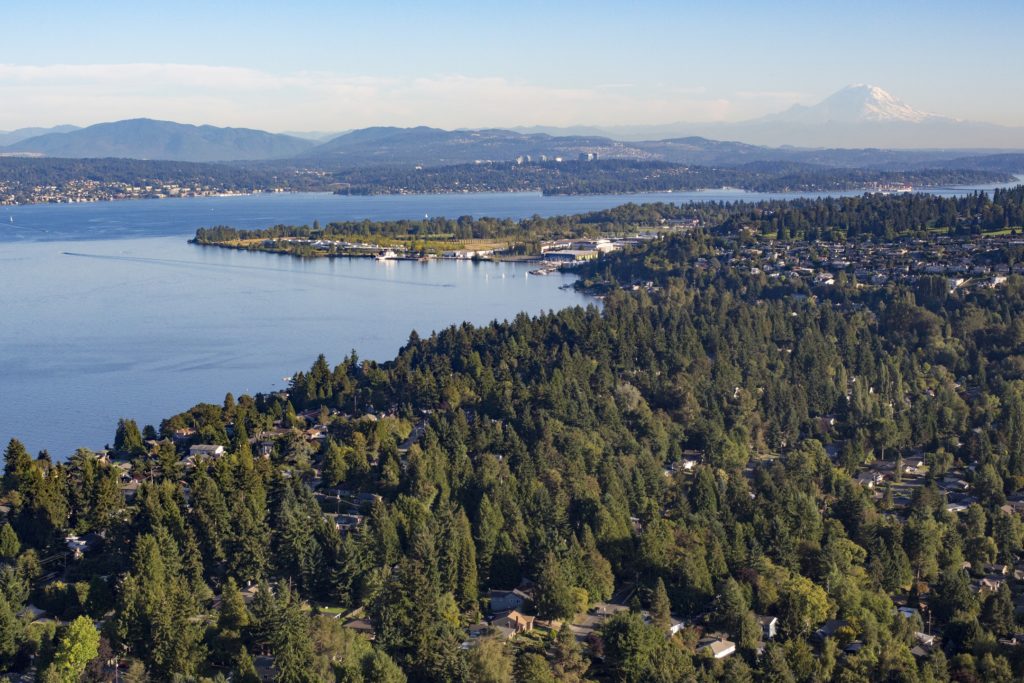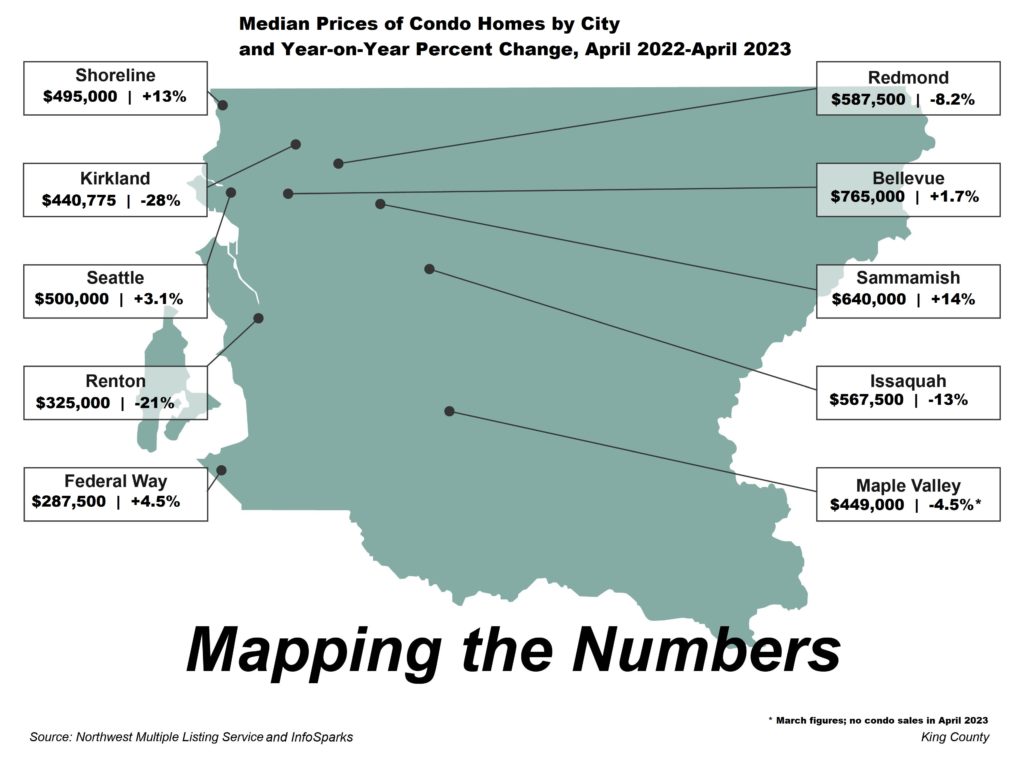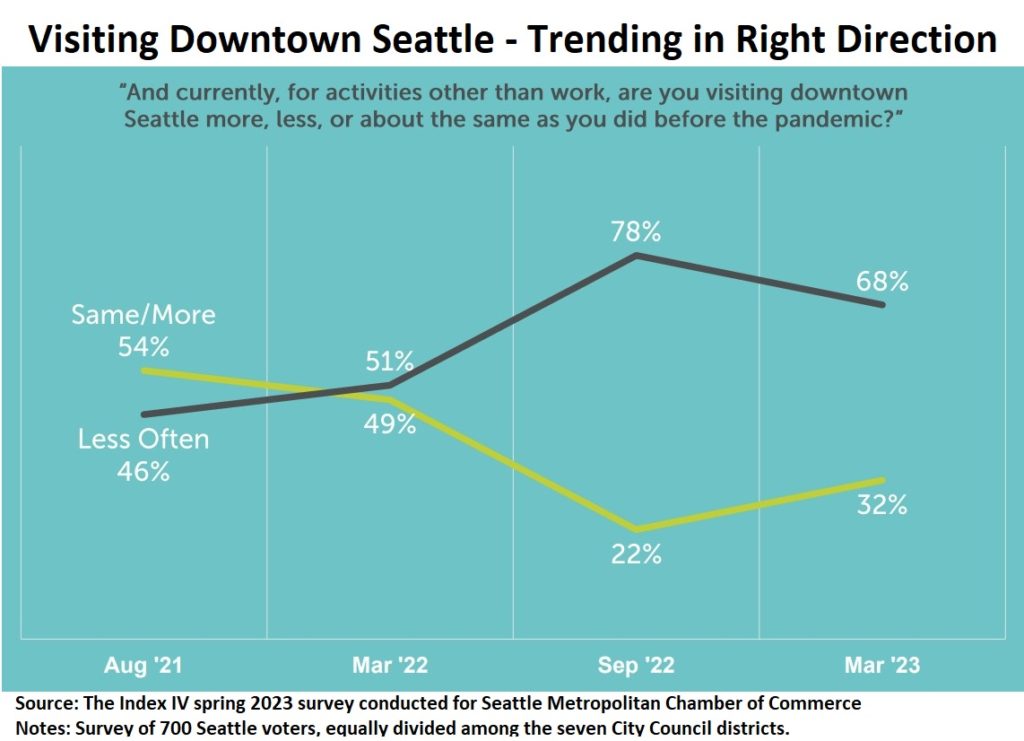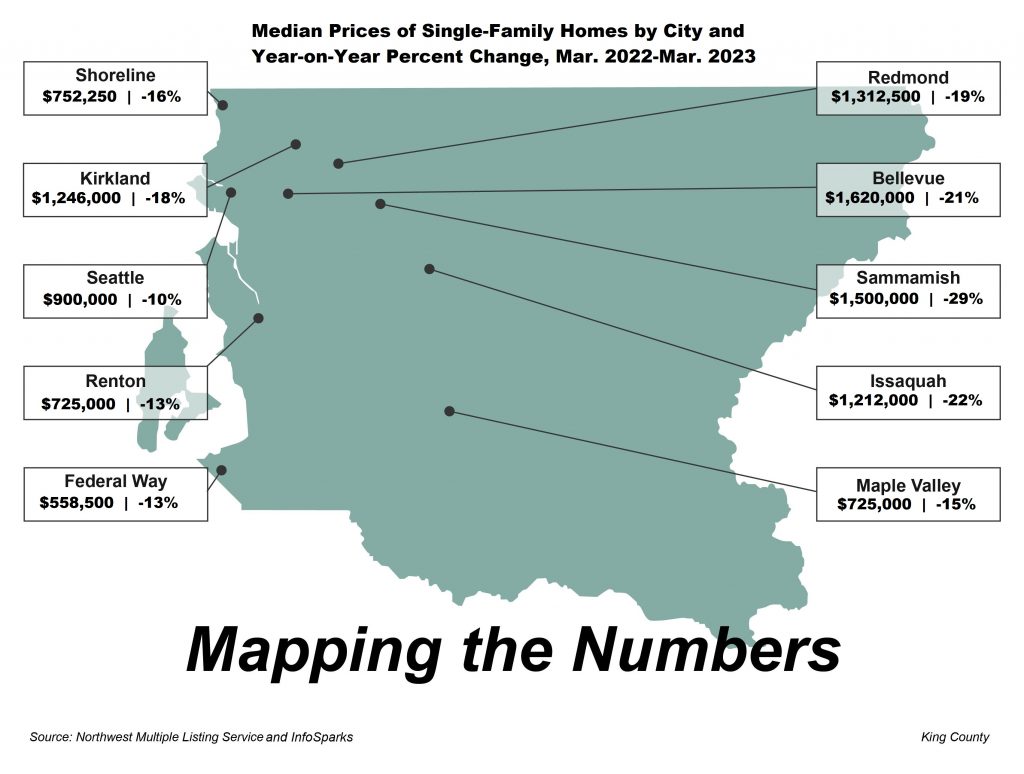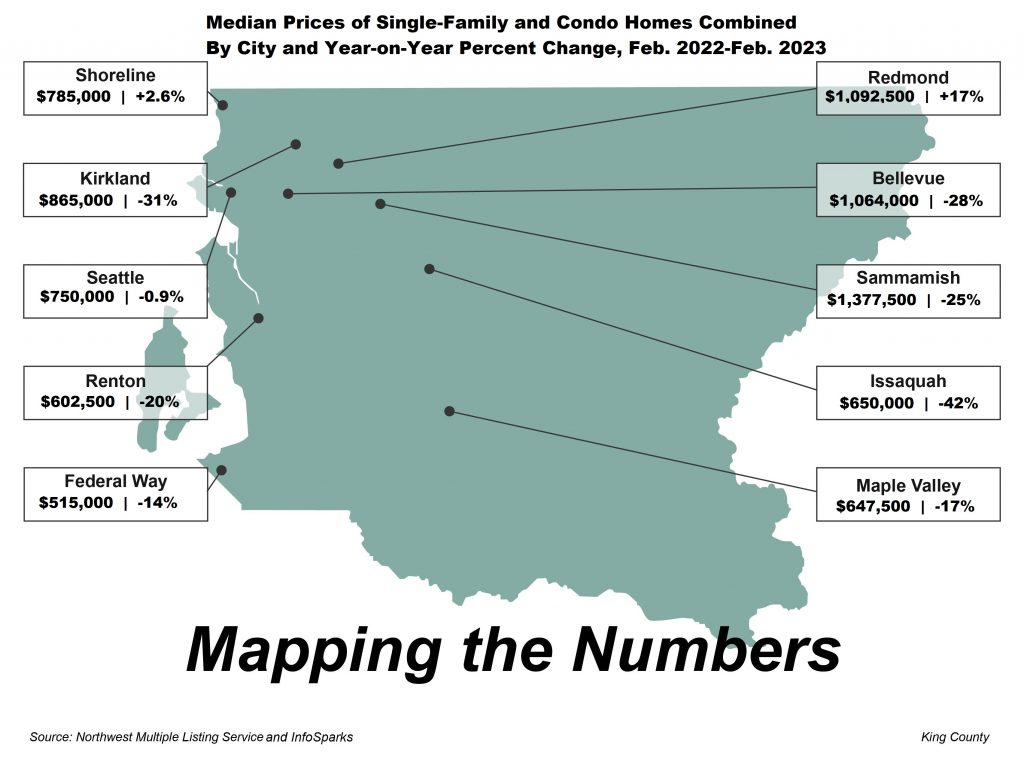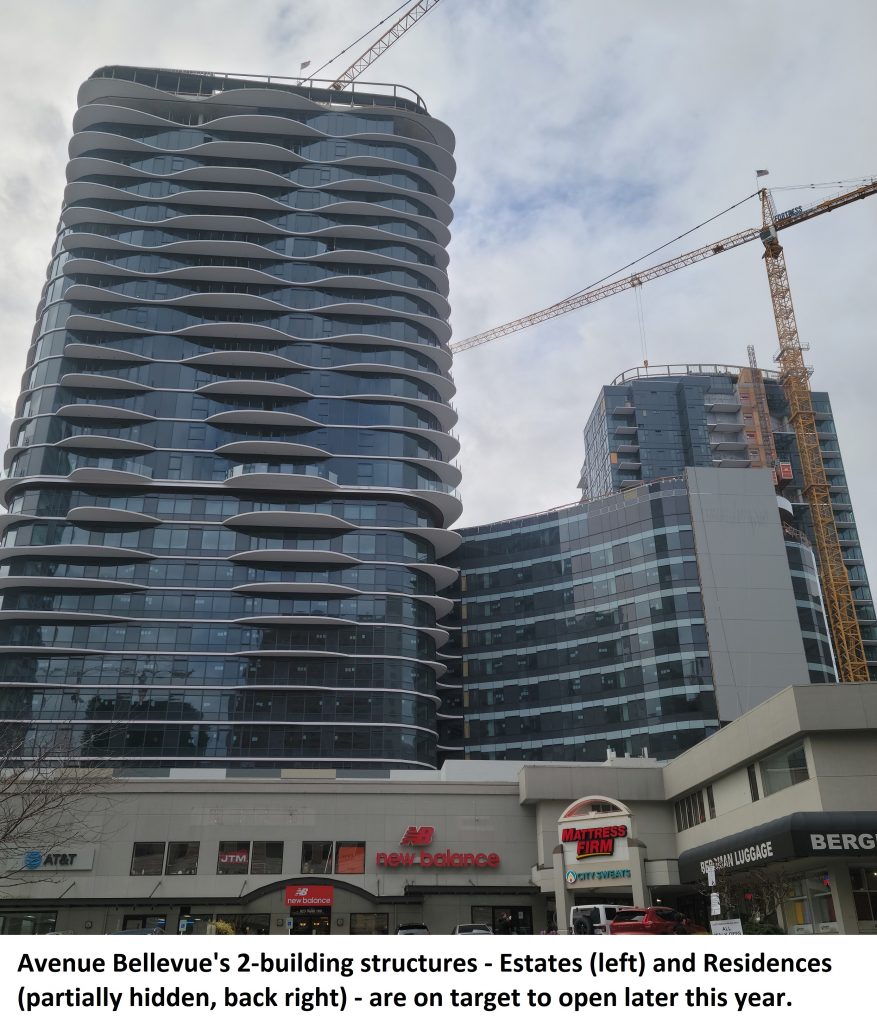
They’re back, by the tens of thousands! But where are we going to put them all?!
No, I’m not talking about Bed, Bath & Beyond 20% off coupons in our mailboxes. Farewell, BB&B! I’m referring to people flocking to the Seattle metro area from across the country and around the world.
Our region had a net gain of 17,750 people in the 12 months ending July 1, 2022. The 2.4% annual growth rate was easily the largest of any major U.S. city and it comes only a year after our market experienced a net loss of about 4300 people.
While I’m all for a growing and diverse melting pot in our region, it’s quite apparent we need a bigger “pot” in the form of more housing. What’s happening?
Much of the acceleration in growth has been driven by a sharp increase in Millennials aging into their adult years and wishing to find a better life. Seattle (including the waterfront, pictured) is America’s most desired post-graduation destination for college students, according to one index. You can’t blame them for wanting to live in a tech-friendly area that embraces living environmentally responsibly as well as enjoying our magical environment of trees, mountains and water.
Harvard researchers looked at data to explore this phenomenon. They found that the number of households headed by 25- to 34-year-olds grew by 300,000 per year in 2016-2021, up sharply from an average annual growth of 45,000 households between 2011 and 2016, a difference of 260,000 additional households per year.
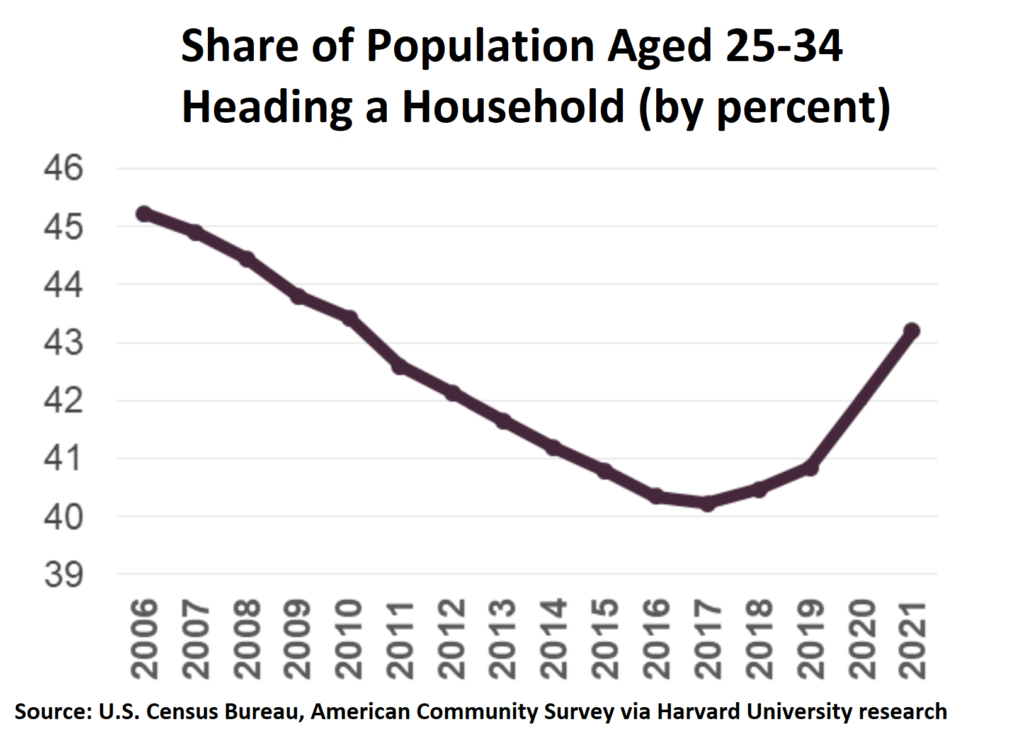
The number of households headed by adults aged 35-44 grew even more rapidly, by fully 400,000 per year in 2016-2021 after having declined by an average of 150,000 per year in 2011-2016. That’s a swing of 550,000 households a year in overall household growth among this age group.
This net gain for Millennials is interesting when you factor our nation’s population growth has slowed for three consecutive years (2019-2021) to 100-year lows. (The Harvard research did not have access to 2022 U.S. Census data.)
This information suggests Millennials are only now forming the households that had been delayed earlier in the decade. We can point to financial constraints (student-loan debt among them) and the pandemic for the slow start.
Another consideration is the smaller households in our area that further boost demand for homes. People living alone numbered 141,000, or 40% of all Seattle households. The average Seattle household comprises 2.08 people, the smallest of any major U.S. city; the figure was 2.94 in 2010.
Can the housing market cope with rising demand? Washington is said to need about 1.1M new homes over the next decade to catch up with population growth. Our state is among five out West experiencing the greatest undersupply of housing in the nation (California, Colorado, Utah and Oregon are just ahead of Washington on the list.)
The state estimates that King County needs 17,000 new homes every year for the next two decades to keep up with projected growth and housing demand. Where to put all the newbies?
The picture is dark (or at least one of our 50 shades of grey): Strong demand, fueled by population growth, along with a housing shortage caused by more than a decade of underbuilding, has buoyed the cost of buying or renting in our region. Even the doubling of interest rates in less than a year did not dissuade some buyers in need of a home.
The lack of housing is arguably the biggest issue facing our region and solving it needs to become everyone’s priority. If we’re right about this, it means fixing this one – admittedly massive – challenge could make our lives much better than we realize by lowering the entry to homeownership for many, thus providing access to better jobs via improved commuting distances and a more cohesive community. The long-range outlook is hopeful and optimistic.
Laws added to the state books this year will certainly go a long way to boost density, particularly near transit hubs, as well as the removal of obstacles toward building accessory dwelling units on nearly any single-family-zoned home. Investment in affordable housing near inexpensive public transportation is a key mechanism to reduce the cost of living, and housing investments can help mitigate climate change when coordinated with transit options. But getting there will take time and resources; permitting new housing projects alone can take 6 months or more.
Converting underutilized office buildings and vacant big box stores (ahem, BB&B!) could potentially generate thousands of homes in areas already served by public transportation. The costs and resources are a huge hurdle to overcome but cities are willing to help.
We need every market-rate and affordable home that developers can produce. Our county has the distinction of having the lowest percentage of Millennial homeowners (38%) in the region, compared with Snohomish (57%) and Pierce (50%). Affordability continues to be the No. 1 roadblock to ownership.
Laws put into place, effective July 23, will undoubtedly help but the challenges remain. They include further:
- Improving homeownership opportunities for first-time buyers
- Reforming building codes to ensure every requirement is worth the delay
- Improving opportunities for minority households to create inter-generational wealth through ownership
- Reducing homelessness that results from lack of affordability
- Earmarking subsidies to the most economically vulnerable households through housing support and low-income homes
Many of these goals can be woven into the comprehensive plan that, thankfully, local governments are reviewing now for their next 10-year cycle that starts in 2024. The time is now to build more because there are no signs people will stop showing up at our door.
BY THE NUMBERS
>> The ratio of U.S. mortgage holders considered “equity rich” – with 50% or more equity in their homes – fell in Q1 to 47.2% from 48.0% in Q4 2022, marking the second consecutive quarterly decline after 10 straight gains dating back to 2020. According to ATTOM Data Solutions, Washington was among the top five states to experience the sharpest quarterly decline; 56.5% of mortgage holders in our state are equity rich, down from 58.5% in Q4.
>> If budgeting $1500 a month to rent a home, Seattle can fetch you a 453 sq. ft. residence, according to research from RentCafe. That places the Emerald City No. 89 among the top 200 U.S. cities for rent affordability. Spokane ranked No. 26 with a 988 sq. ft. home at $1500. Wichita, Kan., earned top marks, offering a 1463 sq. ft. rental home for $1500 and Manhattan, N.Y., was last at 243 sq. ft.
>> Nationwide one in every 4234 housing units had a foreclosure filing in April 2023, according to ATTOM. That’s down 10% from March but up 8% from a year ago. Atlantic City, N.J., has the highest ratio of foreclosure filings, with one in every 1356 housing units. No Washington cities were highlighted in the report. Filings include default notices, scheduled auctions and bank repossessions.
>> Nearly half (47%) of all prospective buyers said they would buy a home in the current housing market because they are tired of renting and rent increases. That’s according to a Bank of America survey of 500 renters completed in early spring. A full 69% plan to buy a home when the timing is right for them, regardless of interest rates and home prices.
>> Boulevard Park in unincorporated King County rated among the top 10 affordable suburbs in which to live, according to national research by Point2Homes. By calculating which suburbs had the highest percentage difference between its median price per square foot and the same data point of its nearby major city, Point2 determined Boulevard Park to be the eighth most-affordable area in the U.S. The 1.6-square-mile area has a population of about 5000 and is located just south of the Seattle boundary near South Park.
>> Approximately 1400 new apartment units are now for lease in Seattle, according to a Q1 report from local commercial real estate firm Berkadia. Another 14,716 units are under construction and more than 25,000 are in the planning stages, meaning they will likely start construction within about a year.
JUNE HOUSING UPDATE
Home prices and mortgage rates. These are the two most frequently discussed items by both the people working in residential real estate and the customers and clients they serve. It’s the bacon and eggs of the housing market – two staples that are often linked to one another.
And the May report for Puget Sound residential sales is no different. Unfortunately for buyers, both figures – prices and rates – are climbing, raising the hurdle to homeownership even higher for many.
Median home prices for King County on all home types added 3.4% from April and 13% since the start of the year to $816,750. Prices were up 5.1% ($830K) in Seattle for the month and 4.5% ($1,253,550) on the Eastisde.
Price appreciation is more extreme for single-family homes across our county. It jumped 4.0% in the past month and a whopping 17% Year to Date (YtD) to $910K. Median prices were up 2.2% ($905,125) between April and May and 13% YtD in Seattle and unchanged ($1.45M) in May on the Eastside but up 9.8% over the first five months of the year.
Read a detailed assessment of our housing market in my most recent blog post: Affordability Woes Keep King County Housing Activity on Slow Burn
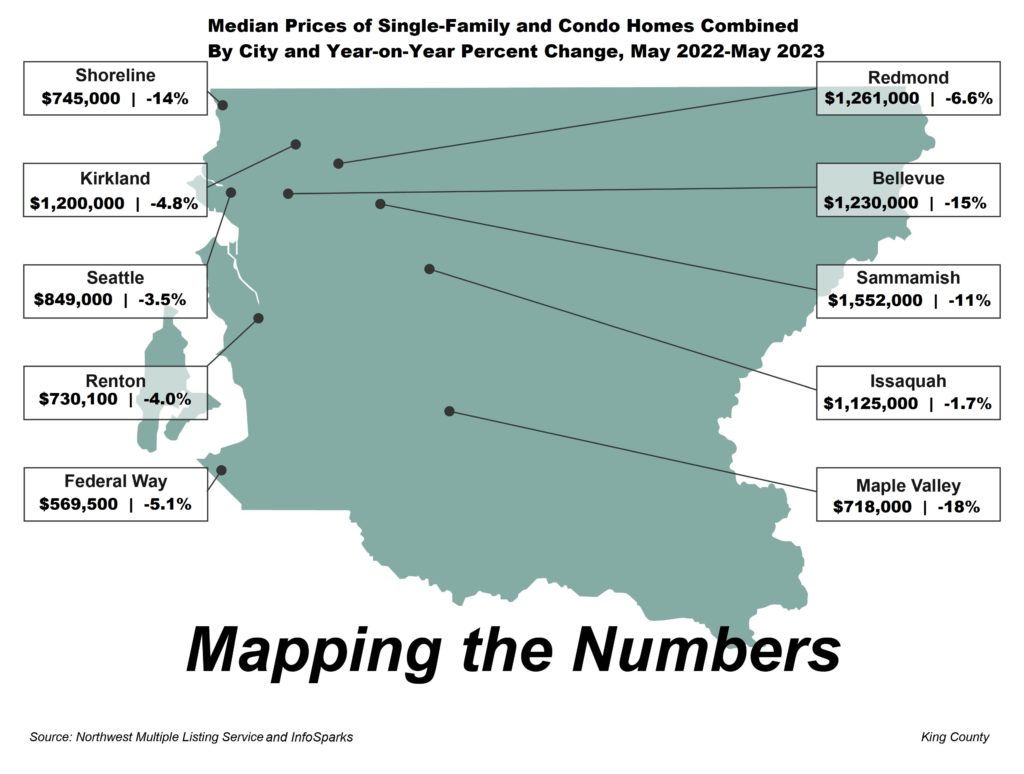
CONDO NEWS
I truly enjoy exploring new condos before buyers can visit on-site. The smell of fresh paint, wood and carpet permeates the structure. And the views, well, there is nothing sweeter than to see a new perspective from high in the sky!
My visits start with a tour of the sales gallery to learn about the qualities of the community and how it differentiates from buildings past. I most recently met with sales reps for Mari, one of the next great offerings coming to Bellevue. This one is going to be special. I wrote a blog post to offer my insights and share this video sneak peek:
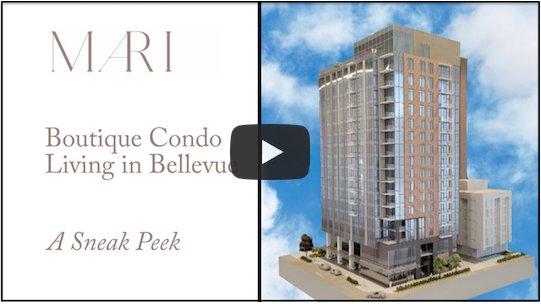
VIDEO: Mari – Boutique Luxury Condo Living in Bellevue
———
Exciting times for Seattle condo shoppers: Graystone has introduced weekly on-site, hard-hat tours of the next big residential offering in the city. The 31-story, 271-unit luxury condo on First Hill is planning to open its doors this summer to owners – but why wait?
Tours inside the gleaming glass and steel tower are available most Saturdays, when you can see built-out homes and amenity spaces as they take shape. Once marveling up-close at the fine finishes, you can take the short walk to the sales presentation gallery and discuss pricing and promotions.
Speaking of which, Graystone recently cut prices by 15%-20% and sales reps are making a limited-time offer of buyer assistance toward lower closing costs and more affordable financing. Wow! Contact me to learn more and schedule a no-obligation visit to Graystone.
LUXURY LIVING
Luxury housing season is in full swing across our region. Here is just a small sample of deliciously delightful homes for sale today:
We start with an absolute stunner in Sammamish. It’s a 4-bedroom, 5-bathroom, 7272 sq. ft., 2-story residence (no basement) on three-quarters of an acre on Long Lake. As you enter the home you are immediately attracted to the wood-plank arched ceilings and custom-stone fireplace wall in the living room that acts as a contrast to the massive picture window onto the lake. The chef’s kitchen is huge, with a center island big enough to be called a continent. Rich wood floors and coffered ceilings in select rooms make each inch of this home special. Secluded, spacious, spectacular! List price: $5M ($687/sq. ft.).
Big family or just a lot of close friends? Then we have a colossal estate that could fit any large group. Let’s start with the numbers: a 5-bed, 5.5-bath, 9590 sq. ft, 2-story, custom-built, New England-style home with basement and 8-vehicle garage on a fully fenced 2.8 acres in the Issaquah Highlands. Everything is BIG: a 12-seat theater, two kitchen islands, a walk-in closest bigger than the typical one-bed home, and 1600-bottle wine cellar nearly large enough to be called Total Wine. There’s even a wet bar in the main bedroom and an elevator. The sellers, Cannabidiol business owners, are reportedly downsizing their living arrangements. List: $7.25M ($756/sq. ft.)
Or about a stately house in Magnolia? It’s a 4-bed, 3.75-bath, 4197 sq. ft., 2-story home with basement. Vaulted ceilings and skylights in select rooms open up this 1939-built abode that feels fresh and modern. A wonderful place for family, friends and fun. For extra convenience, local buses run just a few feet from outside the door. List: $2.898M ($690/sq. ft.)
We finish this month’s roundup by setting our sights on new heights. This 3-bed, 3.5-bath, 3083 sq. ft. penthouse takes up half of the 25th floor in the Belltown condo Seattle Heights. Every inch of this home is classically contemporary. And the views are epic: the city skyline and Queen Anne hill act as bookends to the dramatic views of water and mountains. The interactive floor plan orients you to your fantastic future home! List: $3.45M ($1119/sq. ft.).
What else is happening in and around your Seattle?
Juneteenth, June 17
The national holiday may be on June 19th but Seattle is getting a head start with a celebration to mark the emancipation of slaves in the U.S. You’re welcome to attend this year’s Juneteenth event at the Rainier Beach Community Center (8825 Rainier Ave. S.) to hear speakers, enjoy cultural performances, partake in kids’ activities and savor food from vendors. Free. 11am-3pm
Frolic in Fremont, June 17-18
The wackiest event of the year takes place on Saturday (2pm). It’s the Fremont Solstice Parade, featuring clothed and unclothed (but strategically painted) cyclists who “parade” around the Center of the Universe. A must-see moment (at least once), starting from 3rd Ave. NW and NW Leary Way, then along NW 36th St., Evanston Ave. N. and N. 35th St. Free. Both weekend days offer a fantastic fair with craft vendors, food, beer garden and live music. There is even a dog parade on Sunday from 2pm. Free.
Music Day, June 21
Make Music Day is an international celebration of live summer solstice sounds. Seattle is one of nearly a hundred U.S. cities to participate. Our event will take place in various venues, including Westlake Park in downtown, under the Great Wheel and in city parks. Enjoy the longest day of the year with some free music.
Drinks in Kirkland, June 23-25
Kirklandia is a tasting of “100 Washington craft wines, ciders, and beers,” with tacos, live entertainment, games, competitions and a street market at Marina Park (25 Lakeshore Plaza, Kirkland). Friday, 4-8pm; Saturday, 12-8pm; and Sunday, 12-4pm
Food in Westlake, June 24
Shop from “100+ local crafty food and beverage vendors” at Gobble Up, organized by Urban Craft Uprising at Lake Union Park (860 Terry Ave. N.). Examples of what you’ll find include sauces, teas, kitchenware and plenty of food options. Free. 10am-5pm
Pride, June 24-25
Looking for an outdoor party with a festive atmosphere? Look no further than PrideFest Capitol Hill on Saturday (12-8pm), a street festival and beer garden with live performance stages along Broadway Ave. near Harrison and Republican streets. Free. That’s followed by Sunday’s Pride Parade (11am-3pm) that runs along 4th Ave. from downtown to Seattle Center, where thousands of LGBTQ+ members and their supporters hang out for music, food and fun. (12-8pm). Free
Fourth of July Fireworks, July 4
What would be a Fourth of July be without fireworks? There are celebrations throughout our region, including: Bellevue, Everett, Federal Way, Kent, Lakewood, Sammamish, SeaTac, Seattle, Snoqualmie, Tacoma and Tumwater.
Major League Baseball All-Star Game, July 11
This year marks the first MLB All-Star Game in Seattle since 2001 and only the third in our city’s history. The game’s greatest players will meet for the mid-summer classic (5:15pm). It will be preceded by the Home Run Derby on July 10, which last year featured then-rookie Julio Rodriguez of the Mariners in the derby final (but finished second). 5:15pm (times are approximate)
Bumbershoot, Sept. 2-3
Here is your early reminder that Bumbershoot is right around the corner (hard to believe!) and now is your time to explore ticket options for what is the 50th anniversary of Seattle’s signature Labor Day weekend festival. The event returns after a 3-year hiatus and under new organizers. Among this year’s headliners: Sleater-Kinney, Zhu, The Revivalists, and Fatboy Slim. The music madness and much more – roller skating, wrestling, sign spinners, robots, burleskaraoke (I couldn’t make this up!) – takes place at Seattle Center (305 Harrison St.) Tickets.
Events are subject to change. Please check with venues to confirm times and health-safety recommendations.
In case you missed it….
Home buyers were the center of focus in the past few weeks on my Living the Dream blog. We covered the little-discussed assumable mortgage and how it may help some buyers get on the property ladder. Contract contingencies are significantly important to protect buyers and we list the five most critical conditions to keep in mind. And, we offer our take on the oft-ask question about finding homes near “good schools.”
Thanks for reading! Please share your feedback and tell your friends about this unique offering.




